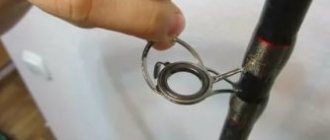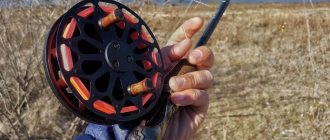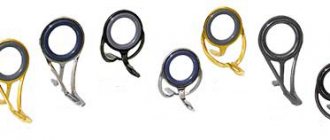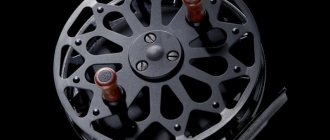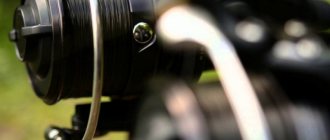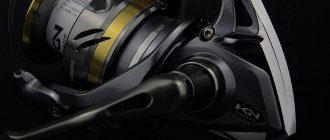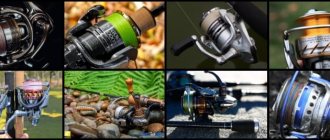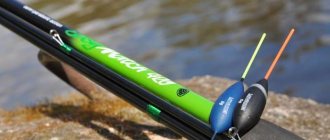Surely every adult in the countryside has gone fishing at least once. Some fans are so captivated by the excitement that they start fishing almost every day. And if you fall for an ordinary bait, most often it is a very small fish, but there will be freedom for the cat, because he is also a living creature. Another thing is modern spinning tackle, which consists of expensive and technically complex elements - rods, reels, equipment.
Particular attention should be paid to spinning reels, for their ideal operation they require timely maintenance, lubrication and, if necessary, repairs.
Why is it necessary to do regular service for coils?
Each piece of equipment, like fishing reels, requires systematic inspection in situations of frequent use, violations of operating rules, as well as to ensure proper storage during the off-season. In particularly difficult cases, coil repair may be necessary.
It would seem that a not so often used element from the kit of an avid fisherman needs to be inspected in a timely manner in order to identify atypical crunching noises, noises and other malfunctions. If the equipment is not stored correctly, the internal parts of the mechanism may rust and also oxidize. Thus, the service life of such a coil will be significantly reduced.
If you take into account the gear you regularly use during fishing, you will notice that the reel most often comes into contact with water and coastal sand. This is aggravated by the fact that the reel, especially the inertia-free one, consists of many small parts (gears, bearings, etc.) that will not work adequately without timely lubrication of all parts.
And the inertialess coil device disassembled
If debris gets into the moving parts of the reel, you must immediately clean the equipment on site.
It is necessary to partially wipe with a napkin, because the sand will remain in inaccessible places, and subsequently cause damage to the bushings, bearings, and gears. Due to this, the life of the coils will be significantly reduced, and this may cause a malfunction.
The device of the inertia-free coil outside
How to understand that a coil service is required
Typically, the need for regular maintenance of a reel operating on the inertia-free principle can be understood by the following distinctive points:
- the period of the first fishing after winter downtime begins;
- mid-season;
- diagnosing atypical sounds and current viewing of all moving elements to make sure there are no unusual noises or difficult movement of internal elements;
- systematic inspection throughout the fishing season in order to determine the integrity of the condition of bearings, gears, bushings, as well as the color of the oil, contamination, leakage;
- extraordinary diagnostics if incorrect operation of the mechanism is detected: uncharacteristic noises arise, there is creaking, moving structures are difficult to move, backlash has formed, there is sand contamination.
Lubrication and repair of spinning reels should be carried out several times a season and after falling into water or sand.
In reality, it is optimal to do diagnostics quite often - every 2 months during the season. This frequency must be observed if there are no tangible indications for immediate diagnosis.
Thus, diagnostics and periodic inspection will help avoid more serious breakdowns.
The most popular problems and their repairs
Depending on the type of coil and its design features, problems may arise during operation, some of which are easy to fix yourself. Let's look at the setup principles in more detail:
- Lost pen. This is the most popular problem. To avoid losing the handle, choose those models that have a washer and bushing for attaching the handle.
- Self-resetting of the line laying machine. The line handle is folded down during casting. Usually this problem leads to the bait being shot, and in more severe cases it can damage the rod. Sometimes this problem can be fixed by simply tightening the bolts securing the arc. If this does not help, then you need to remove the cover that hides the spring and either replace it with a more elastic one, or add hardness to it by installing a gasket on the rod that secures the spring.
- Constant line breaks. Braided fishing line has less springiness than monofilament, and on some models of spinning reels it breaks when casting. The problem may be due to the fact that the clutch locking nut is 1.5-2 mm higher than the edge of the spool. The line catches on the nut and gets under the edge, gets tangled there and breaks. This problem is eliminated by installing a plastic gasket. To do this, you need to remove the locking washer, then remove all the friction washers, and then replace the felt pad with a thin plastic one. Having installed the parts in place, you will see that the locking nut is level with the edge of the spool, and the line can no longer catch.
- The line is fed in a spiral. This malfunction is due to dirt getting into the line roller. The bearing rubs, the line does not pass through it, so it twists and does not feed smoothly. Repair consists of disassembling, thoroughly cleaning and lubricating parts.
- Internal noise. If while fishing you hear any sounds uncharacteristic of a spinning reel, then you must stop any work with it. They can be associated with serious damage. It is possible that dirt simply got inside the mechanism, but there is also a possibility of damage to the bearings. The coil needs to be disassembled and, depending on the problem, either cleaned or replaced damaged parts.
- Uneven winding of line. It often happens that the line is wound onto the spool along an oblique line, forming either a front or rear cone. There are washers of different thicknesses on the main shaft. If the line is wound with the cone down, then to fix the problem you need to remove one washer. Accordingly, if the cone is directed upward, then the washer needs to be added.
Carp fishing for beginners - a guide that will pave the way to the world of carp fishing and big trophies.
Edible Rubber Guide - Expert analysis and detailed analysis of the best brands and models of flavored baits.
Have you tried fishing with a bombard? Try this exciting spinning tackle.
How to lubricate a spinning reel
Lubrication for spinning reels is sometimes done without prior disassembly; you need to use silicone grease, produced in a liquid state. It is produced in cylinders equipped with a simple dispenser. Using a thin dispenser, you need to introduce the required amount of product and turn the mechanism.
But you need to understand that this method of lubrication cannot be used for a very long time. In order to operate the product optimally, you should periodically disassemble the reel into parts and lubricate each element separately.
There is a video on the Internet about how to lubricate a reel:
How to disassemble a spinning reel
First you need to remove the reel handle, spool and spool holder. These parts are easy to remove, as the manufacturer has provided mounting structures.
Then the shaft sleeve is disassembled, where the adjusting washers and bearing are located. Here you need to use tweezers and simple toothpicks.
The overrunning clutch cover is secured with bolts. They must be unscrewed using a suitable screwdriver. Often the bolts are designed with asterisks or hexagons. This fact must be taken into account in the process of preparing the required tool.
Remove the coupling from the bearing and wipe the contaminated areas dry with a rag, as well as remove dirt and debris. To most effectively remove all deposits, VD-40 is used.
Then you need to unscrew the anthers. After this you will be able to remove the cover.
Here you will have access to the gears. You will need to make special marks on the teeth so that the marks match exactly during the assembly process. Then the coil will work exactly as before.
Next, the main gear and stop box are dismantled.
Now you can disassemble the carriage, which is fixed with a stopper. Once it is removed, the first part is simply dismantled.
After this, the coil is completely disassembled. It is advisable to film the entire disassembly process, this will allow you to easily reassemble the coil after completing maintenance.
Important information! As a result of correct actions, the device is disassembled into all components. The correct step would be to lay out all the resulting parts on a dry, wiped surface in the sequence of dismantling work that was done.
It is optimal to record a specific stage of all actions in a photo for clear perception. Thus, there should be no problems during reassembly.
Symptoms of damage and how to eliminate them
In order to carry out competent repairs of inertialess coils with your own hands, as well as inertial ones, you must first determine the cause of the breakdown and do it correctly. Of course, after disassembling the product, you can clearly see the part that has failed. However, the manifestation of certain symptoms of problems will help with a high probability of identifying the failed part before the coil is disassembled.
Types of faults and their manifestations:
- Internal noise. If any extraneous sounds occur in the product during use, you should immediately stop using it. It is not necessary that the noise is caused by a damaged part; it can also be caused by dirt getting into the mechanism. However, if the reason is not contamination of the product, then most likely the bearings have failed. Then, in order to repair a fishing reel, it will be enough to replace the worn parts.
- Creak in the coil. Constant creaking inside the body signals the fisherman only one thing - it’s time to disassemble the reel, clean it of old lubricant and treat it with new one. Determining which part or assembly is the source of the squeak is quite problematic. Therefore, it is better to carry out full maintenance of the product.
- The line is wound unevenly on the spool. Sometimes the following situation begins to occur - the fishing line is unevenly laid on the spool, forming a front or rear cone. This is easy enough to fix. If winding occurs with the cone down, then it is necessary to remove one washer from the main shaft of the reel. If a cone forms upward, a washer needs to be added.
- The line-laying bow self-resets. If a similar problem occurs, repairing a spinning reel with your own hands should be done in the following order. First of all, you need to tighten the shackle bolts; this problem is quite possible due to loosening. If a positive result cannot be achieved, then you need to increase the spring stiffness. You can either replace it with a suitable one, or install a gasket under the rod to compress the weakened spring and give it the necessary properties.
- The reverse stopper fails. Since the stopper mechanism is based on an overrunning clutch, most likely such a malfunction is not due to a breakdown, but to simple contamination or accumulation of thick lubricant. In this case, the entire repair of the coil will consist of disassembling the coupling, cleaning and lubricating it.
- Mechanism wedge under load. If, when reeling in the fishing line, distinct knocking noises are heard from the reel, and under a certain load it generally jams, then with a high probability we can say that the main gear mechanism is damaged. Repair of the coils in this case is carried out by replacing the gears of the main transmission pair.
- Line breakage due to the clutch nut. Reels with a front clutch may suffer from the following drawback: when casting, the unraveling line clings to the clutch nut and breaks off. It is clear that the issue here is not a breakdown, but a design flaw, since the nut protrudes 1-2 mm beyond the side surface of the spool. In this case, repairing the reel clutch is easy - disassemble the nut and replace the thicker felt gasket with a thinner one made of plastic.
In order for the product to serve you in the long term, it must be used correctly and carefully, carry out periodic maintenance and promptly respond to any signs of deviation of the coil from normal operation.
Expert opinion Nikolay Mikhailovich Knipovich Zoologist, hydrobiologist
I am interested in fishing at a professional level.
Important! The quality of the repair depends not only on the accuracy of disassembling the coil, but also on the quality of the reassembly. Carefully wash the disassembled products, put them in order - then the repair will most likely be completed efficiently and successfully.
You should not put off repairing spinning reels for too long - delay will only aggravate the situation and accelerate the destruction of not only damaged parts, but also those that interact with them. This will lead to higher repair costs or even failure of the product!
Experienced fishermen do not recommend disassembling and lubricating a high-quality new reel for 1-2 seasons. If there are no problems, only light lubrication of the rotating parts is permissible to facilitate sliding. Also remember that some damage can be avoided by knowing the rules for using reels - for example, when returning home from fishing, do not leave the clutch tightened, loosen it. This will help avoid deformation and sticking of the friction discs during long periods of inactivity of the reel!
Recommendations and rules
There are several important tips and rules at the same time:
- lubricant must be taken with good moisture resistance and with a significant temperature range;
- the lubricant should not have any odor;
- after completing the service, you need to rewind or replace the cord;
- The taper and quality of its winding should be checked and, if necessary, adjusted by removing or adding adjusting washers.
Maintenance of the baitcasting spinning reel:
How to lubricate spinning reels
Common tips for lubricating spinning reels:
- Optimal lubricant from the same company that manufactured the reel.
- Before applying the lubricant, you need to carefully remove the waste residues of the previous one. Typically, two lubricants cannot be mixed with mineral and synthetic components in the composition.
- In extreme cases, Tsiatim 203 is suitable as a lubricant for a spinning reel, and oil used for household sewing machines is suitable as a liquid composition.
- There is no need to lubricate the coils with WD-40 liquid or motor oils. In particular, you should not do this for a reel containing a large number of plastic parts. It is important! Additives and WD-40 liquid used in motor oils can destroy the coil mechanism.
Lubricant for spinning reels EFELE is suitable for all components:
Lubricant for spinning reels EFELE
How and with what to lubricate a spinning reel - video instructions from disassembly to assembly:
How to lubricate
Disassembled parts should not be lubricated separately, as during assembly the parts will slide, making it difficult to install in their place. Because of this, there is a possibility of the elements slipping out of your hands and falling onto a dirty surface, and this may lead to the need for repeated cleaning.
It is better to lubricate the entire mechanism assembly, and do a complete disassembly to remove sand, water and remnants of old lubricant.
Fishing is a fun pastime, but to be successful, you need to take preparation and maintenance cycles seriously on important parts in your fishing equipment.
Do-it-yourself inertial coil repair
Repairing an inertial coil with your own hands is not a difficult task; it is not taking apart an inertia-free coil, which includes about a hundred elements. The homeland of both is the UK, where the inertial fishing reel is called a centre-pin fishing reel - a reel on a central axis.
Over the centuries, it has changed greatly not only in terms of elements, but also in the material of manufacture, becoming from wood to metal. The name has also changed - rotating drum reel, which translates as a rotating drum. In slang it is also called centre-pin, and English fishermen understand perfectly well what we are talking about.
Inertia coil brakes
The simpler the inertia device, the more unpretentious it is in operation and maintenance. It’s one thing if the reel consists of a body, an axis and a drum, another if the mechanism has various systems, including a braking system, which we wrote about in the article “How an inertial reel on bearings works.”
Inertial ratchet brake
In ordinary Russian-made drums, it is located on the back side of the wheel and is similar to a tongue that operates in two positions. When deactivated, the tongue does not come into contact with the gear, so the drum rotates freely. If you move it, the tongue will engage the gear teeth, and the resistance to rotation of the wheel will depend on the stiffness of the spring.
Because of the characteristic sounds, such a brake got its name. It is believed that such a system is convenient for beginners to avoid overrunning the wheel when the cast fades away. On most inertia engines, the amount of braking can be adjusted.
True, there is one “but”... Quite often it is simply impossible to finely adjust the brake, and therefore the drum has to be braked manually. European analogues have absolutely no braking system.
Inertia clutch
Often, inertial reels are equipped with a friction brake, but it is not always adjustable, like the Nelma reel. With this device, it is simply activated by moving the lever, and it comes into operation with a load of about two kilograms.
It is also possible to find reels with an adjustable clutch on sale. It is impossible not to mention such a function as a reverse stopper. Its purpose is to protect against spontaneous unwinding of the scaffolding during transportation. Experienced fishermen manage to use it when removing large specimens of fish from a reservoir or when fishing with a line.
So, let's summarize why the reel needs a braking system:
- To prevent wheel overrun when throwing tackle. This is not so relevant for float gear, but the issue is acute among spinning fishermen.
- To avoid overrunning the drum during a sharp bite and when pulling fish out of the reservoir. A sharp jerk of the fish can tear the handle out of the hands of the spinner and lead to the formation of a beard.
- For clear fixation of the drum during transportation.
The friction brake works most simply, which in some models resembles a car shoe. If the angler presses on the top of the wheel, the inside of the cheek comes into contact with the block. By changing the pressure, you can adjust the braking speed.

